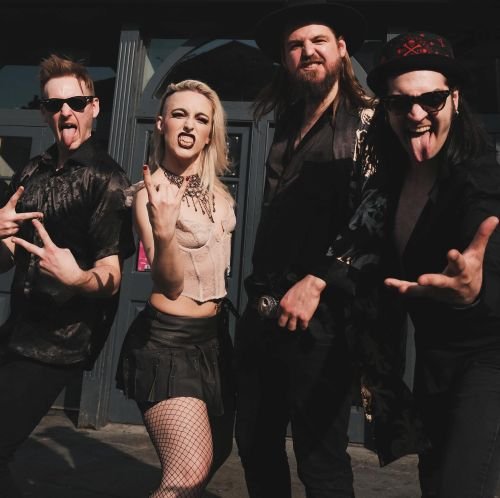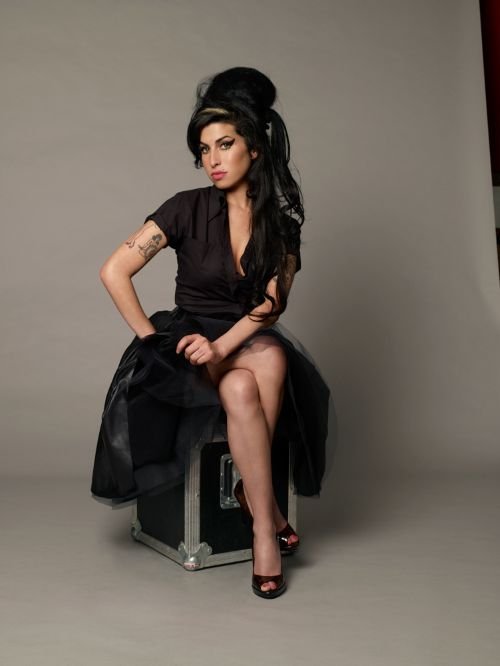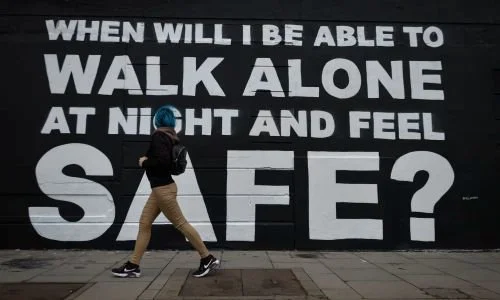FEATURE:
Spotlight
South Arcade
_________
ONE of the most exciting bands around…
I want to spend some time with South Arcade. Formed in Oxford in 2021, the band went viral for videos of their band practices. They also performed at BBC Radio 1's New Music Live in Halifax, West Yorkshire in November 2024. Their debut E.P., 2005, was released last year. I am going to end with a review for that E.P. I want to start out with some interviews. Going back to December, South Arcade chatted with Kerrang! about their year and what lies ahead:
“2025 is the South Arcade takeover!”
Vocalist Harmony Cavelle’s proclamation isn’t wrong. While 2024 has been an unbelievable time for the Oxford Y2K core trailblazers, plans are already in place to take the band’s rise even higher. Truly, this time next year, they could be anywhere.
Joined by guitarist Harry Winks, bassist Ollie Green and Oodie-wearing drummer Cody Jones, South Arcade meet Kerrang! amid a “crazy week of announcements” to take a breath and look back at how they got here, as well as what’s on the horizon.
“I think the beginning of the year was pretty tough,” admits Ollie, “because there’s no definites in this world, and especially doing music. But when it all started getting a bit better is when we stopped worrying. There’s a lot of pressure to have a good TikTok or good whatever, and it was the moment we sort of went, ‘Let’s just try and enjoy it, and capture the bits we enjoy.’”
It’s an approach that’s worked wonders. With the quartet picking up new fans and followers thanks to a steady string of superb singles throughout 2024, not to mention behind-the-scenes social media videos inviting people in their brilliantly chaotic world, South Arcade are killing it on every level.
And, crucially, they’ve proven that online numbers can translate into reality, as they found out when they stepped onstage at August’s Reading & Leeds to a packed BBC Music Introducing crowd. (If you want an idea of just how well that went, next year they’re coming back to play the main stage.)
Today, South Arcade cap it all off with their debut EP 2005 – a six-track release that collates their five latest singles, and the new title-track. Here, the band tell us all about it, and reveal why they’re so excited to take it across the world next year.
“I don’t know if I’ve got a suitcase big enough,” laughs Harmony. “I need to buy some new clothes! We’re excited to have a proper plan, and meet all these new people. It’s gonna be incredible…”
How would you rate 2024 for South Arcade? From the outside looking in, it feels like everything’s pretty much exploded…
Harmony: “Definitely! It’d be rude not to give it a 10/10, right? Well, it’s a 10 so far, I don’t know if anything will change in the rest of the month (laughs). But honestly, I don’t think we could have asked for more this year. The support we’ve had – whether it’s from people coming to gigs, or online, or whatever – we’ve been so lucky. People have really been reacting to the videos we’ve been doing, and the music… I don’t want to jinx anything, but it’s all gone very well! We’ve been very lucky.”
Has it all caught you off guard, or did you start the year like, ‘Things are going to happen for us’?
Harry: “I think stuff like numbers online doesn’t really feel real until you see people in the crowd. We had our first gig back at Reading & Leeds after some stuff had happened on TikTok, and we got to see the new audience that we’d gained for the first time, and that was really special.”
Cody: “I cried. In a good way! It was one of those things that you can’t really comprehend – it’s just, ‘Oh my god, this is crazy.’”
The whole year has probably been like that – just constantly going, ‘How do I process this?’
Harmony: “Oh yeah, definitely. We totally set out at the start of the year, ‘Come on, guys, we’re gonna really hammer this home and do everything we can.’ But like Harry said, until you step out on that stage and see people’s mouths actually moving along, it feels so surreal! But also, I think it’s spurring us on for next year, going, ‘How can we take this to the next level?’”
You’re wrapping things up nicely with the 2005 EP. Was it always the plan to get the singles together and put out something a bit more substantial?
Harmony: “It was a really big thing for us to have people see the world and everything that we’re trying to create with the band. And when the singles started falling into the EP – the first one on it is Nepo Baby – it’s the first time when we really started to feel like we’d found our sound. It was like, ‘Okay, this is our lane and we feel strong here.’ We know what we want to create.”
Harry: “It was very natural. Nepo Baby was the first song we dropped in 2024, and it felt like a new era of music, so it was the natural thing to put all the songs together. And it also feels like it encapsulates the whole vibe.”
Harmony: “It’s been such a fun EP to make, and there’s different vibes in each song – they all create a different world. And now it’s so nice to have them all together, and for people to have that as a thing to listen through and know that it’s how we want it to be presented. It means a lot to us, and it’s really exciting.”
Harry: “We’re doing something different with each song. People know that we coined the ‘Y2K core’ – well, I don’t know if we made that, I think I heard it on the radio…”
Harmony: “It’s what I put in the bio of Spotify!”
Harry: “It’s a cool phrase to simplify what we do, but it is more than that. Each song pulls from a different favourite genre of ours from the 2000s – whether it’s nu-metal or pop-punk. There’s a lot of Britney and Gwen Stefani, even if it’s just subtle.”
Harmony: “And then there’s the Limp Bizkit and Linkin Park reference.”
Harry: “With Linkin Park coming back recently, too, that’s spurred us on. That sound is cool again.”
Harmony: “Yeah, it’s like, ‘We’re on the right track!’ But with the EP as a whole, there’s the Y2K core thing, but we also do like to add a modern spin to that. And what we all really want from it is to end up in everyone’s playlists. Whether it’s the people who get the references and are in that demographic, or the young kids who are finding this music for the first time – that’s awesome, too. We just want to be able to provide that nostalgic escapism.”
Do you feel any pressure in terms of this being a proper debut body of work? Or because people have heard most of the singles already, you’re pretty relaxed?
Harmony: “I think because we’ve been waterfalling the tracks, it’s nice to have everyone on this journey with us, from the start to the end. We’ve picked up all these new people on the way, and then with 2005, we’re hopefully introducing even more people. It’s almost like the family or fanbase that have been with us this whole period, it’s a gift for them, and it ties us all together.”
Harry: “We’ve had this journey with the fans, song by song.”
Harmony: “Because they’ve been the ones where, all this amazing stuff that’s coming up next year, they’ve made it possible”.
They have already got off to a blinding start to 2025. Single Supermodels is among their best work yet. I wonder whether the band will release an album later in the year. With festivals ahead, you can imagine South Arcade being invited to quite a few of them. The first one is from Ticketmaster from February. The band explain how a lot of fun is missing from music:
“Within your sound there are obvious nods to 2000s pop-punk and metal, but there are also some great glitchy pop moments and huge rock riffs. Every song you release had a slightly different take on that core sound, but what always sits at the centre is a huge hook. As fans of music, where do you think your appreciation of a simple, undeniable hook comes from?
Cavelle: I think a lot of that comes down to the actual writing process. It starts out with our guitarist, Harry, who is our producer as well. He’ll make about 20 little minute-long song ideas, he’ll show us all of them, and I’ll end up liking one or two out of the 20. Then, we’ll sit for a week trying out all these random words as freestyles, almost like Simlish. There’ll be parts that stick, and I live with my family, so you’ll hear them singing one of them around the house. That’s when you know you’ve got it, and a big thing for us is to not overcomplicate it. We’re trying to make it catchy and not too highbrow. It needs to be enjoyable for people that like heavy music, but also for people who just want a catchy tune.
Green: It’s a feeling as well. If it feels cool, then why over complicate it? We don’t want to do a Jacob Collier and make something crazy, that’s his niche. None of the stuff we love is complicated, it all just has a good feeling. Less is more, and it just makes you feel good.
Cavelle: What we’re realising now with our music is that having that hook is a big thing, but it’s also about having that coolness or sassiness to it. We’ve got some stuff underneath which is quite heavy, so we could easily go down that angry, sad route, but we love putting fun into the songs. We love the tongue-in-cheek stuff, and we love having a bit of promise in our tracks. We’re making them fun, rather than taking the easy route of going angry.
Green: I don’t know what other bands are like, but we’re not really into brooding or making angry songs. We like listening to music that has at least a bit of optimism, a bit of hope.
Cavelle: We feel like a lot of fun is missing from music now. When people come and see us live, we just want to give them a fun night. You should have a good time listening to music, it doesn’t have to be serious, arms folded and highbrow all the time. There’s a time and place for that stuff, but a big thing for us and all of our newer fanbase to is just to have fun with it. Everything else is so sad and depressing right now, so let’s just have a good old time.
We have to touch on the battle between South Arcade and North Arcade that started out in the ‘HOW 2 GET AWAY WITH MURDER’ video. Talk us through the inception of that story and the encounter that takes place…
Cavelle: It was majorly inspired by Scott Pilgrim. The song itself is a bit tongue-in-cheek, even just in the title. If you see a metal band with the name ‘HOW 2 GET AWAY WITH MURDER’ you think, “Oh god, okay. This is going to be some heavy stuff!” We were thinking about how we could put it into a cool concept video, and we have our reality in it, but it links to the cartoon. We love Gorillaz, and you can get a cartoon to do anything. If it was us in the music video, knocking someone over and knocking them off a cliff… I’m not sure if that would fly. Since it’s cartoons though, you can get away with it. It was a super fun one, and the animator that we chose to work with got what we were going for. With the North Arcade thing, that was just a one-off idea we had about some alter-ego thing…
Green: South Arcade is on a sign in Oxford. There’s a shopping centre called the Westgate, and it’s there. We’ve been round and looked at all the other signs, and there is a North Arcade. It became a thing that friends would say as a joke; “What band are you in? North Arcade?” At one point, someone probably had a drink and thought, “Oh, I wonder what North Arcade would be like?” They ended up taking the form that they did as weird alter-egos of ours, which was fun. You don’t want a serious music video for that song. If you do a brooding live performance thing…who wants to see that? You want a bit of fun, and being animated, you can tell much more of a story with it. The possibilities are endless, and Harmony is a big fan of cartoons. That’s another thing [that was better] about the 2000s. Now, you’re seeing 3D live-action Bob The Builder – get me the 2D guy back! We just love that time, as well as the art and culture that was around then.
Cavelle: Everything had so much more integrity and a sense of meaning. It sounds so snobby, but it’s not. Maybe it’s because we were younger and naiver, so stuff from then seems more magical and creative, but now everything seems so soulless.
Right now, there seems to be a cohort of bands focused on bringing the idea of the music video back. Music videos used to be a way to discover new music, and often fans would actually discover songs through seeing these iconic videos. That artform seems to have been lost recently…
Cavelle: When I was younger, the first thing I did when I got home from school was put on the Top 40 music charts. The way you found your music taste was through watching these videos, and it’s so cool because the concept is exactly what the artist wants you to see. The song is playing as well, and it makes you put two and two together. You get the artist; you get what the whole thing is about. That stuff started dying down, and I can’t even find the charts on the TV now when I want to. People don’t care about music videos so much now, and a lot of people argue that it’s a waste of time and money, but I think that visuals are so important in understanding the meaning of the song. You see how a band’s meant to be perceived, if they’re serious or not serious, and you get that from watching one video. That’s how you used to discover stuff from MTV, and I don’t think that’s the way anymore, but we are seeing it through YouTube now. We haven’t even tapped into our YouTube that much. We’ve only posted about 40 videos in total there, but the way that people are finding us through that now is reassuring.
Looking towards the future for South Arcade, obviously it’s a tough time to be in the music industry right now. Despite that, what keeps you waking up each morning knowing that this is something that you want to keep pushing towards?
Green: We just enjoy it. The truth is, and I might be getting a bit overly earnest and sincere here, but we are quite good friends. All music aside, we get on, and there’s a bond between us that’s like siblings. We will gladly bicker to no end, but it’s in the same way that siblings do, it’s never deeper than that. We share a love for what we’re doing, and we share a love for going out and playing. We’re doing it because we like doing it.
Cavelle: As a band, so many people have given us their time and come to the shows. Now, our listeners are going up, and it almost feels like we have a responsibility to provide this music and these shows for people. We’re very grateful and feel honoured to have that responsibility, and we want to be these people’s favourite band. Not just because they perceive us as these untouchable, higher beings – we want to be perceived as everyone’s friends. We’re just trying to have a good time, and I think that’s what everyone needs right now. That’s definitely what keeps us all going, and it is so much fun. We’re grateful for the opportunities we’ve had so far, and a year ago there’s no way I would have thought we’d be doing all of the stuff that we got coming up. It’s surreal.
Green: We were doing it when we thought no one cared, and I think that shows that we’re doing it for the fun of it. We’d sit there and go, “What if no one cares?”, but we enjoyed it, and we liked making music, so we just kept going. We like going out and playing shows together, and even if it’s just to 10 people, that’s fine. That’s cool, because we’re doing what we enjoy, and if other people are getting some enjoyment out of it – job well done. Now, it’s just an extension of that. When you enjoy doing something so much, it’s not a chore. It’s a privilege”.
Before finishing off, I want to drop in a recent interview from NME. Hailed for their incredible and electric live shows, together with their mining of the sounds of the 2000s, it is no wonder South Arcade are getting a lot of attention. The remainder of this year will be very busy:
“Has that blend of nostalgia and newness led to you having fans from all ages and backgrounds?
Cavelle: “That has definitely come across. The blurring of boundaries is not something we were consciously looking for, but it’s exciting because it has created a kind of pendulum effect. We were wanting to bring this nostalgic, real-band sound back… but some of these 13 or 14 year old kids are discovering it for the first time! They’ve never heard that before, they’ve not had the chance to see it live until now.”
Green: “Then there’s the other side of the pendulum. The people telling us that they went to see these great bands back in the day, and that we’ve reminded them of that. It’s funny because we’re not in either camp — we’re in this weird in-between area.”
Cavelle: “It’s because of that placement that we’re making this wide fanbase, though. It’s cool to be received by all camps in such a positive way– and to see that it’s not just us who likes it! Part of the appeal is us not taking ourselves too seriously, though. We just want to revive this fun space.”
What was it like to see that sudden spike in interest when ‘DANGER’ went viral?
Green: “It was quite surreal and a bit daunting. It’s weird too, because we’re inspired by the 2000s, but that era didn’t really have that same ‘viral’ thing that we have now. The idea of everything moving so quickly is overwhelming, but it’s also exciting. It actually came at a great time for us too, because by that point we had the mentality of: ‘we’re going to make whatever we want because we enjoy it.’ So, it paying off felt like a sign that we were doing the right thing. It reminded us to have more faith in our process.”
Cavelle: “It’s easy to fall into that mindset of: ‘this has got to perform well’, and then you start doubting yourself. That’s a dangerous space to get into, so it was a relief that doing our own thing worked out like that.”
You’ve managed to continue that momentum, and now many of your fans are discovering you through your immense live shows. What is it about playing live that makes South Arcade come to life?
Cavelle: “When we’re writing our tracks, we’re so conscious about, ‘will this go off when played live?’ If we can’t jump to it, just the four of us in the room, it’s crossed out. For us, it’s all about harnessing that energy and having a good time. We know that people often discover us from a screen, so when they do take the chance on us and come to see us live, it restores a bit of faith for us.”
2024 was a big year for the band, how are you continuing the momentum into 2025?
Cavelle: “There will be new music, and it will definitely tap into something we haven’t done yet. There’s more of an electronic side coming through now. Something more dance-focused. We have a new single called ‘Supermodels’ and it should be out on the night of our show at KOKO!”.
I am going to finish with a review from Distorted Sound Mag for South Arcade’s 2024 E.P., 2005. I know they will be releasing a lot of music across the coming years. If you have not heard of them yet then do make sure they are on your radar. A band that you will not want to miss out on:
“SOUTH ARCADE are slowly perfecting their soundtrack and it is subtlety shown throughout the record. Their lyrical structure has softened and is more loose and playful with ad-libs and vocal FX, perfectly exemplified on HOW 2 GET AWAY WITH MURDER. The random car key sound effect does feel more like engagement bait for social media than a harmonious audio choice but nevertheless, each song does not feel overly juvenile. All are well crafted and polished, beyond what one might expect from such a green band. Across the board, the content of the songs are playful and engaging if not a little emotionally simplistic. stone cold summer, Riptide (and the rest of their discography) perfectly captured the youthful nature of young adult romances and frustrations and, like all good things, just needs a few years to marinate and mature.
SOUTH ARCADE have bared their teeth with this EP; their flair is starting to show but there is ample room for them to push it even more and lean deeper into the grit and grunge with more adventurous vocal styles and heavier riffs. Whilst their origins have come from jamming together in a garage, 2005 shows that SOUTH ARCADE are ready to evolve and collaborate on a more professional setting. Their teeth may not be fangs just yet, but they are definitely sharp and their milk teeth have long fallen away.
Rating: 7/10”.
I am new to South Arcade so have been doing a bit of catching up. They are a really interesting and promising band that have the sound and chemistry to go a long way. I do think they will be playing huge shows and headlining festivals in the future. For those who have not discovered them, do connect with them and make sure you don’t…
MISS out.
___________
Follow South Arcade





















































